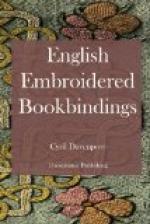The value of ‘purl’ was recognised some few years back, when I had some made, and explained its value and use to the Royal School of Art Needlework at South Kensington, and I believe they used it considerably.
[Illustration: 51—Psalms. London, 1646.]
On books the use of purl is generally auxiliary, but one small book bound in white satin, and measuring 4 by 2-1/2 inches, a copy of the Psalms, printed in London in 1646, is entirely embroidered in this material, helped with gold braid and cord. The design is approximately the same on each side, a large flower with leaves in the centre, and a smaller flower in each corner. On the upper cover the centre flower is yellow and red, with two large green leaves, and the corner flowers are, possibly, intended for a cornflower, a jonquil, a lily, and a rose, but the material is so unwieldy that the forms are difficult to trace, and flowers worked in it are likely to assume forms that are unrecognisable, when finished, however well designed to start with. All the flowers and leaves are made with the purl cut into short lengths, drawn together at the ends by a thread run through, thus forming a succession of small arches. The stalks are made in gold cord. The flowers on the other side are, perhaps, a carnation in the centre, and round it a convolvulus, lily, daffodil, and rose. The back is divided into five panels, in each of which is a ‘purl’ flower, all worked in the same way, representing successively a tulip, cornflower, carnation, lily, rose, or something analogous to them; round the designs are straight pieces of brown purl, and the edges are bound with a broad gold braid. There are no ties or signs of any, and the edges are simply gilt. The purl is undoubtedly very strong; I possess a small patch-box worked on white satin in a similar way to this little book, and although it has been roughly used for some two hundred and fifty years, the colour of the purl is still good; the upper surfaces of the small spirals, however, show the copper wire bare almost everywhere. The book, not having had anything like the hard wear, is in very good condition, but it is too small for the proper use of so much thick thread. The larger leaves and petals are made in relief by being sewn on over a few pieces of purl laid underneath them at right angles.
[Illustration: 52—Bible. London, 1646.]
Bible. London, 1646.
A Bible printed in London in 1646 is bound in white satin, and embroidered in coloured silks and gold braid and cord, measuring 6 by 3-1/2 inches. The same design is on both sides. In the centre within an oval of gold braid and cord is a spray of vine, with two bunches of grapes, three leaves and a tendril, the fruit and leaves worked in silk, and the stem in gold cord. Enclosing the oval is an arabesque design worked in gold cord and guimp, and at each corner is an oval of thin gold strips and gold cord; the gold strips are done in the manner known as ‘lizzarding,’ and are kept down by small stitches at intervals.




